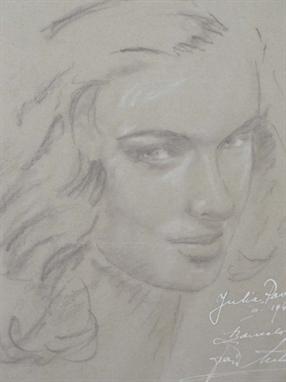283284 Preisdatenbank Los(e) gefunden, die Ihrer Suche entsprechen
283284 Lose gefunden, die zu Ihrer Suche passen. Abonnieren Sie die Preisdatenbank, um sofortigen Zugriff auf alle Dienstleistungen der Preisdatenbank zu haben.
Preisdatenbank abonnieren- Liste
- Galerie
-
283284 Los(e)/Seite
SIR DAVID YOUNG CAMERON RSA RS RSW RWS (1865-1945) Letters of provenance attached verso and inscribed West Highland Museum, particulars of the proof from a copper plate for printing currency-notes designed and engraved by Sir Robert Strange 1746. This proof has been printed and signed by Sir D Y Cameron RA from the copper plate with eight designs 2 1/4 by 1 7/8 inches of CP (monogram for Charles Price or Carolus Princeps) on a cartouche with coronet and Price of Wales feathers above, over a trophy of arms and flags; on the entablature below are the values on four of the designs-one, two, three and six pence; the other four entablatures being left blank, "the interior part to be filled up by clerks" (Sir Robt. Strange`s memoirs vol.1 p.52). The plate was found near the west end of Loch Lagan, probably thrown aside during the flight from Culloden 1746. It was presented to MacPherson of Cluny, was exhibited in 1865 and later, and illustrated and described in vol.VI of the Proceedings of the Society of Antiquaries of Scotland pp.47 & 85 and also yb Miss Helen Farquhar in an article on "Portrait Medals Struck for Prince Charles" in the British Neumismatic Journal vol.VII second series pp.206-8. The plate is the work of Sir Robert Strange, then a young artist in Edinburgh, who hastily prepared plates on a sudden call for currency caused by the loss of the "hazard" sleep on its way from France with a large sum of money on March 25th 1746 and in Strange`s diary-quoted in Miss Farquhar`s article-he describes the hurry and difficulty of the engraving. His commission is for notes of amounts from £200 downwards but no notes were printed and nothing of the proposed issue has survived with the exception of the plate described. The reason of this is that the plate was only delivered to Prince Charles`s Treasurer a day or two before the Battle of Culloden and the other for larger sums was never complete. In the memoirs of Sir Robert Strange p.54 he tells the story of how, in his ignorance of the proper ingredient, used in etching, he found the aqua-fortis "playing the devil with it" strong traces of which can be seen on the plate. An interesting parallel with the proposed issue of these notes is afforded by the coinage of "Gun Money" by James II who in 1689 and 1690 caused pieces from the crown to sixpence to be struck from any gun metal, brass, and copper that could be collected. About £3.0*** in nominal value was issued and on the defeat of his adherents the issue passed current at its intrinsic value as metal only. The plate was bought by friends at the sale of the Cluny Castle Relic in London, June, 1928, and presented by them to the West Highland Museum at Fort William. This addition of proofs is a limited one of thirty seven impressions. Another letter verso from the West Highland Museum is dated 1928 and addressed to the new owner with a receipt for five Guineas. 24cm x 23cm Private Scottish Collection.
A GEORGIAN MAHOGANY BUREAU WITH CHEQUERED INLAY ON BRACKET FEET - REPUTEDLY BELONGING TO SIR ROBERT PEEL OF DRAYTON MANOR TOGETHER WITH AN OIL ON CANVAS PORTRAIT OF SIR ROBERT PEEL TOGETHER AND HIS LIFE PRESERVER . For sale as one Lot at the request of the family: These three items have been passed down through the Eaton Family, from Lichfield, after originally been given as a token of respect and friendship by Sir Robert Peel himself from his family estate at Drayton Manor...All three items reportedly belonged to Peel himself during and after his time. Sir Robert Peel, 2nd Baronet (5 February 1788 – 2 July 1850) was a British Conservative statesman who served as Prime Minister of the United Kingdom from 10 December 1834 to 8 April 1835, and again from 30 August 1841 to 29 June 1846. Peel, whilst Home Secretary, helped create the modern concept of the police force, leading to officers being known as "bobbies" (in England) and "Peelers" (in Ireland) to this day. Whilst Prime Minister, Peel repealed the Corn Laws and issued the Tamworth Manifesto, leading to the formation of the Conservative Party out of the shattered Tory Party. The Bureau is a Mahogany, drop front with internal drawers and compartments; the lower section has four graduating oak lined drawers with brass handles and key escutcheons. The bureau stands on shaped bracket feet, is rich warm medium walnut colour with a striking grain, good patina. The Oil on canvas measures approx 62 x 74 cms in gilt frame, with some damage in various sections, unsigned. The ‘Life Preserver’ is a double ended, made from whalebone and lead. Approx. 30cms
-
283284 Los(e)/Seite






















































